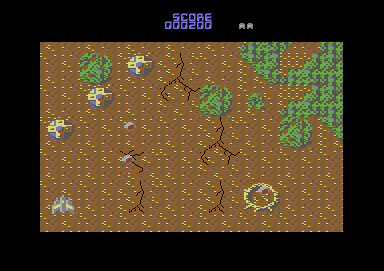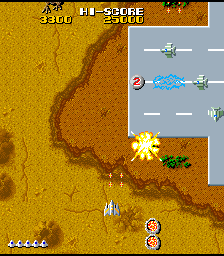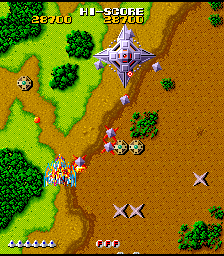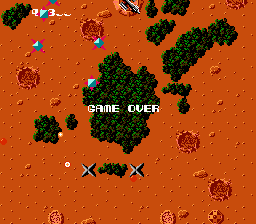Retro Replay Review
Gameplay
Terra Cresta builds on the solid foundation laid by Moon Cresta, transforming static formations into a dynamic, power-up driven shoot-’em-up experience. Players pilot a lone fighter craft on successive bombing runs across a fortified alien planet, tasked with obliterating ground turrets, enemy ships, and other hostile installations. The core of Terra Cresta’s gameplay loop revolves around precision dodging, target prioritization, and the intelligent use of power-ups to survive increasingly punishing waves.
(HEY YOU!! We hope you enjoy! We try not to run ads. So basically, this is a very expensive hobby running this site. Please consider joining us for updates, forums, and more. Network w/ us to make some cash or friends while retro gaming, and you can win some free retro games for posting. Okay, carry on 👍)
A standout feature is the numbered power-up bases scattered across each level. By shooting these anchor points, you release ship fragments that latch onto your craft. Collect all available fragments to unlock “Formation Mode,” which – when activated via the space bar – rearranges your fleet into devastating new firing patterns. Timing Formation Mode effectively can mean the difference between clearing a crowded screen of foes or being overwhelmed by crossfire.
Each planetary pass culminates in a boss encounter, escalating the stakes as you progress. The first two bosses test your mastery of movement and firepower, while the final guardian demands you enter the fight at absolute peak strength. Should you fall in battle, Terra Cresta spares no mercy: your run resets to the very first stage. This “one life” policy amplifies tension, rewards memorization, and cements Terra Cresta’s reputation as a true arcade challenge.
Graphics
For its time, Terra Cresta delivered vibrant, crisp pixel art that leapt off the arcade cabinet. The color palette balances earthy browns and greens for ground installations with bright, neon shades for enemy projectiles and power-up icons. This contrast ensures that threats and bonuses remain highly visible, even when the screen is filled with overlapping bullets and explosions.
Sprite work in Terra Cresta remains remarkably detailed. Your ship—and its detachable formations—have distinct silhouettes that make it easy to track multiple hitboxes on-screen. Enemy turrets and alien vessels each boast unique animation cycles, from rotating gun barrels to pulsating energy cores, adding visual variety across the game’s limited number of stages.
Backgrounds, though relatively static, employ subtle parallax scrolling to suggest depth as you soar over mountainous terrain and fortified bunkers. Occasional environmental flourishes—like smoke plumes from destroyed structures or flashing beacon lights—underscore the sense of a living, besieged world. All told, the graphics of Terra Cresta still shine today as an example of thoughtful, functional arcade design.
Story
Terra Cresta unfolds in the shadow of its predecessor, Moon Cresta, shifting from orbital skirmishes to a full-scale planetary invasion. The narrative premise is straightforward: an alien armada has entrenched itself on a distant world, constructing impregnable fortresses to block any relief forces. As the sole pilot of Earth’s last defense squadron, you must blaze a trail through enemy lines to liberate the planet’s surface.
While Terra Cresta’s storyline is primarily conveyed through sparse, flavor-text arcade screens, it succeeds in framing each level as a critical battlefront on the road to planetary freedom. The numbering of power-up bases—1, 2, and 3—reflects not only in-game mechanics but also an underlying narrative of rebuilding and reinforcements, as your ship’s power grows with every segment recovered.
The final confrontation, where only maximum firepower will suffice, carries a satisfying narrative payoff. It’s a classic David-versus-Goliath struggle: your humble fighter versus the ultimate war machine. Though light on plot twists, Terra Cresta’s premise is delivered with clarity, providing enough context to drive the relentless onslaught without bogging down the action with superfluous exposition.
Overall Experience
Terra Cresta stands as a seminal shoot-’em-up that balances accessibility with unforgiving challenge. Newcomers will be drawn in by the intuitive power-up system and straightforward level progression, while veterans will appreciate the precise enemy patterns and the risk–reward calculus of activating Formation Mode under fire.
The game’s steep learning curve and brutal “one life” restarts can frustrate casual players, but they also underpin the addictive drive to improve. Each successful run through all three bosses feels like a hard-earned victory, and the urge to climb the high-score table ensures replayability long after the initial playthrough.
Whether you’re a retro arcade aficionado or a modern gamer seeking a taste of ’80s shooter heritage, Terra Cresta delivers. Its tight controls, inventive power-up mechanics, and memorable boss battles combine into a classic experience that has influenced countless titles since. If you crave fast-paced action and strategic depth in a compact package, Terra Cresta remains a must-play gem from the golden age of arcades.
 Retro Replay Retro Replay gaming reviews, news, emulation, geek stuff and more!
Retro Replay Retro Replay gaming reviews, news, emulation, geek stuff and more!









Reviews
There are no reviews yet.